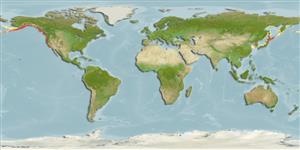>
Perciformes/Cottoidei (Sculpins) >
Rhamphocottidae (Grunt sculpins)
Etymology: Rhamphocottus: Greek, rhamphos = bill, peak + Greek, kottos = a fish without identificaction (Ref. 45335); richardsonii: Named after John Richardson, naturalist and explorer (Ref. 6885).
More on author: Günther.
Environment: milieu / climate zone / depth range / distribution range
Écologie
marin démersal; profondeur 0 - 165 m (Ref. 2850). Temperate; 66°N - 32°N
North Pacific: Japan to Alaska and at least Santa Monica Bay, southern California, USA.
Taille / Poids / Âge
Maturity: Lm ? range ? - ? cm
Max length : 8.9 cm TL mâle / non sexé; (Ref. 48784)
Épines dorsales (Total): 7 - 8; Rayons mous dorsaux (Total): 12-13; Épines anales 0; Rayons mous anaux: 6 - 7. Caudal fin well rounded.
Inhabits intertidal areas and to 165 m depth, in tide pools and rocky areas but also sand bottoms (Ref. 2850). Frequently observed taking shelter in empty shells, including those of the giant barnacle, Balanus nubilis, and discarded bottles and cans (Ref. 48784). Young feed on zooplankton and invertebrate and fish larvae; adults feed also feed on crustaceans (Ref. 28499). May use its pectoral fins to crawl over rocks and seaweed (Ref. 6885).
Life cycle and mating behavior
Maturité | Reproduction | Frai | Œufs | Fécondité | Larves
A female chases a male into a rock crevice. She keeps him there until she lays her eggs (Ref. 28499).
Robins, C.R., R.M. Bailey, C.E. Bond, J.R. Brooker, E.A. Lachner, R.N. Lea and W.B. Scott, 1991. Common and scientific names of fishes from the United States and Canada. Am. Fish. Soc. Spec. Publ. (20):183 p. (Ref. 3814)
Statut dans la liste rouge de l'IUCN (Ref. 130435)
Menace pour l'homme
Harmless
Utilisations par l'homme
Aquarium: Aquariums publics
Plus d'informations
Taille/ÂgeCroissanceLongueur-poidsLongueur-longueurFréquences de longueursMorphométrieMorphologieLarvesDynamique des populations larvairesRecrutementAbondanceBRUVS
RéférencesAquacultureProfil d'aquacultureSouchesGénétiqueElectrophoresesHéritabilitéPathologiesTraitementNutrientsMass conversion
CollaborateursImagesStamps, Coins Misc.SonsCiguateraVitesseType de nageSurface branchialeOtolithesCerveauxVision
Outils
Articles particuliers
Télécharger en XML
Sources Internet
Estimates based on models
Preferred temperature (Ref.
123201): 4.7 - 15.9, mean 8.9 °C (based on 558 cells).
Phylogenetic diversity index (Ref.
82804): PD
50 = 1.5000 [Uniqueness, from 0.5 = low to 2.0 = high].
Bayesian length-weight: a=0.01995 (0.00906 - 0.04395), b=3.01 (2.83 - 3.19), in cm total length, based on all LWR estimates for this body shape (Ref.
93245).
Niveau trophique (Ref.
69278): 3.4 ±0.37 se; based on food items.
Fishing Vulnerability (Ref.
59153): Low vulnerability (10 of 100).
